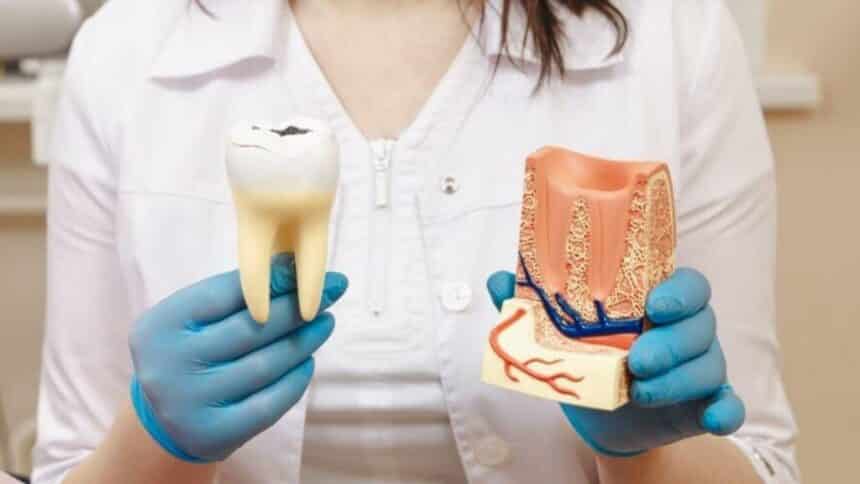If your teeth have suddenly become hypersensitive to various factors and also seem longer than before, visit your dentist for a consultation. You may have exposed tooth necks, i.e. gum recession. You can find out what it actually is, what the symptoms can be and how the treatment works below.
What is gingival recession?
Gum recession is the atrophy, the gradual receding of the gum line, which results in the exposure of the roots and necks of the teeth. This in turn leads to a number of unpleasant discomforts. These can include sensitivity to external influences or pain and bleeding during tooth brushing. There may be more reasons for bleeding gums, if you want to know them, check out this post: "Bleeding gums - causes and treatment".
Another important symptom that can indicate gum recessionis the visual elongation of the tooth mentioned in the introduction. This is a reason for a dental consultation. You should also use it if you feel a depression between your tooth and gum.

Where do exposed tooth necks come from?
There can be many causes of gum recession. More often than not, several occur at once. An example? Poor oral hygiene, i.e. brushing the teeth too short or infrequently, for example, causes bacterial plaque and tartar to build up on the teeth in large amounts.
You can read more about tartar in this entry: "Tartar on teeth - find out how it affects your health". But beware - it's not good the other way round either! Brushing your teeth too aggressively and using a hard-bristled toothbrush can be one of the causes of exposed necks.
Remember that a toothbrush will unfortunately not always remove everything. So make sure you have regular hygiene - ideally every six months. You can read more about it here: "Dental hygiene in the UK - scaling, tooth sandblasting, polishing and fluoridation".
There are also several gum diseases, the neglect of which can lead to their recession. This is in fact one of the most advanced gum diseases. Others include gingivitis, periodontitis or periodontitis. You can read more about it here: "Gum disease - causes, symptoms and treatment".
Other causes of gum recession can include smoking, teeth grinding (read: "Bruxism, or teeth grinding - where does it come from and how to get rid of it?"), improperly performed filling and sometimes even orthodontic treatment. Unfortunately, genetic predisposition and, more specifically, a thin gum phenotype can also be the cause. You can read more about the influence of genetics on our dentition here: "Grandma's smile, or how genes affect teeth".

Consequences of lack of treatment
One of the consequences of exposed tooth necks can be an increase in sensitivity to external factors. This includes the temperature and taste of food, as well as ordinary touch. Teeth affected by gum recession cannot be whitened either.
In addition, with exposed dental necks, there is a increased risk of caries, as well as erosion and abrasion of tooth surfaces.
However, the most serious consequence can be tooth loss! Why does this happen? Due to the fact that the bone surrounding the teeth decreases, they can start to wobble. And as a consequence, they fall out.

Treatment of gingival recession
One way to stop and cure gum recession is to smooth the surface of the tooth root and remove the calculus that is below the gum line. Most often, this procedure needs to be repeated several times.
Another method of treating exposed dental necks is treatment with the device "Vector Paro Pro", which we use in our practice.
The Vector Paro Pro uses ultrasound to reach the deepest nooks and crannies of the mouth and leave them smooth, clean and free of bacteria. It is able to remove subgingival plaque, but also supragingival calculus. It is also excellent for treating periodontitis: "Modern periodontitis treatment in the UK with Vector Paro Pro".
If there has been extensive gingival atrophy, another way to is a graft. To do this, a piece of palate or gum is taken from elsewhere, which is then used to cover the exposed tooth root. We wrote more about this in our article "Surgical coverage of gingival recession„.
Another surgical procedure can also be used. The dentist will apply a special regenerative material to the cleaned area to induce the tissues to regenerate.
Prevention is key
Following the principle that prevention is better than cure, we would like to remind you about regular hygiene. Cyclical tartar removal is one of the best things you can do for your teeth. You can prevent many diseases of the teeth and gums this way.
Above all, however, remember proper oral hygiene - Brush your teeth twice a day. Don't skip flossing either. You can read more about it here: "How do you floss your teeth and why is it so important?".
If you have any questions, welcome to contact or to make an appointment.

